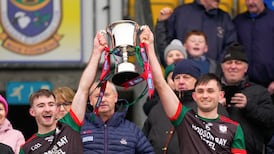It is fitting that Kilkenny and Galway on Sunday mark the 40th anniversary of their first All-Ireland because 1975 is the start of modernity with the introduction of 70-minute finals and it also marks the year that hurling in the West came to the game's top table and took a permanent seat.
The game always had some sort of a profile in Galway and the county - at times through benevolent design - featured in All-Irelands intermittently from the very first championship in 1887. It was though cut off from the rest of the game in Cyril Farrell’s memorable phrase by “history and geography”.
Nowadays better known as a pundit and analyst, Farrell played a vital role for Galway in managing all three senior All-Ireland successes - a strike rate that hasn't been bettered in this era by anyone apart from Brian Cody.
The problem for the county is that the most recent of these championships was a receding 27 years ago but that disguises the extent to which Galway has been modern hurling’s greatest success story, a previously fitful presence that is now a powerhouse of the game.
Whereas it has undeniably Kilkenny’s era in the era since Galway’s last All-Ireland, the counties are actually deadlocked in the accumulation of all of the other elite national titles.
Judged over a range of competitions both senior and under-age we see that Kilkenny have racked up 31 titles (10 league, eight minor, seven under-21 and six club All-Irelands). Galway equal that total (five, eight, six and 12).
Yet the Westerners haven’t won a single MacCarthy Cup in that time whereas their opponents on Sunday have amassed 12.
The county in some ways represents the type of occasional prominence that counties like Clare, Waterford and Limerick enjoy because of similar histories but in this case geography has been kinder in that having the run of a province has guaranteed access to the later stages of the championship (Galway holds the record for All-Ireland semi-final appearances).
It still didn’t count for a lot up until 1975. Up until the great breakthrough of 1980, Galway hurling had to content itself with one All-Ireland.
Interestingly, there was an enduring reminder of that in the person of Jim Power, who passed away in 1998 as the oldest surviving All-Ireland medallist. Born in 1895 he went on to be a member of the Galway team which won the 1923 All-Ireland hurling final, held over until September 1924. He played full back with the county and his local club, Tynagh, with whom he won five county medals.
Then GAA president Joe McDonagh paid tribute on his passing: “Jim Power was an inspirational figure to generations of Galway hurlers”.
Power had been among the crowds who had greeted McDonagh on his return to the county having been elected in 1996. Power also knew the only other Galway man to have been president, Peter Kelly who was elected in 1889 and referred to by the new president in his acceptance speech.
McDonagh - who went on to captain the county in the 1979 All-Ireland and who memorably sang ‘The West’s Awake’ after the following year’s success - in many ways symbolised the journey of Galway hurling.
A self-described 'Coiste kid,' he grew up in the 1960s after the county had implemented the proposals of the Coiste Iomána, a hurling initiative set up by then GAA president Alf Murray and enthusiastically organised by McDonagh's father, Maitias and was one of the first generation of Galway children to be shaped by the work of the county's, Coiste Iomana,.
This committee was responsible for Galway’s transformation from a mainly football environment in the 1960s into one of the strongest hurling counties in the decades that followed.
None the less from the 1920s to the 1970s the game had been sustained through the generations and in his memoir [ITALS]Over The Bar, Breandán Ó hEithir gave an interesting sketch of hurling in Galway around the mid-point years.
“As we have seen, the Galway hurlers seemed to be heading for that long-awaited All-Ireland between the mid-1940s and the early 1950s, and interest in hurling in the county was intense. Even when the county team was in the doldrums, attendances at county hurling finals were always bigger than at county football finals, and the heartland of Galway football lay far away from the city in those years.”
He goes on to recount the high point of that era's challenge, the 1953 final against a Cork side on the way to three-in-a-row All-Irelands. That particular final was infamous for an incident in which Christy Ring is alleged to have hit Mickey Burke.
Ring was then twice attacked again allegedly by Galway players over the All-Ireland weekend in firstly, the Gresham and the next day in Barry's Hotel. Ã" hEithir's view was the "Galway county board made a meal out of the incident" but it was an interesting example of the county's tendency to retreat into siege in the face of controversy and was seen nearly 40 years later by the threats to withdraw from the All-Ireland if Tony Keady had to serve a suspension.
Being a peripheral presence in the hurling world - geographically - has probably fed the idea of isolation and resentment that other counties have it easier within the First World provinces of Munster and Leinster.
Galway have however been willing to take a hit for the betterment of the game over the years.
Every structural tweak to the championship has pushed the county farther and farther from its former birthright of automatic All-Ireland semi-final places but it hasn’t complained despite the unwillingness of Leinster, where it now competes, to take its under-age teams or allow the county a few home matches in the championship.
On Sunday though, Galway once again get the opportunity to go fully mainstream in the only way that history really recognises.
e-mail: smoran@irishtimes.com











